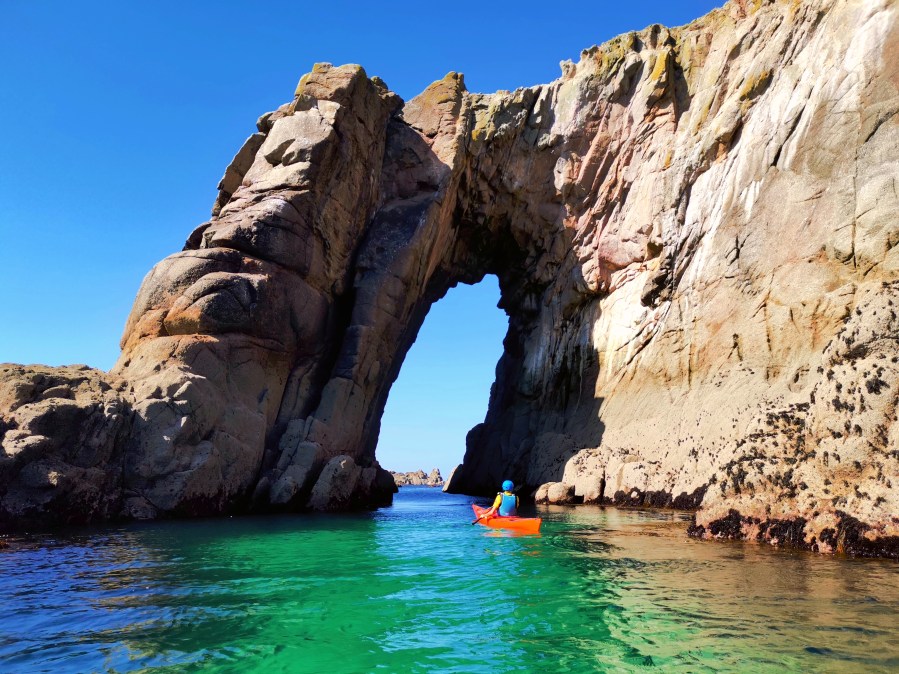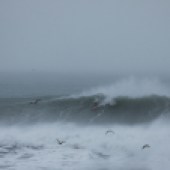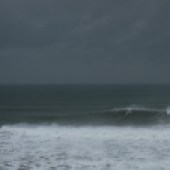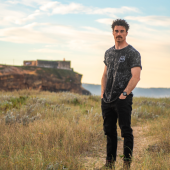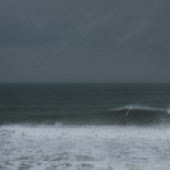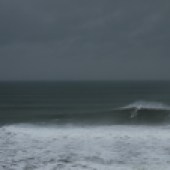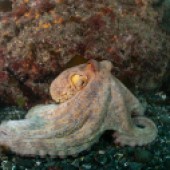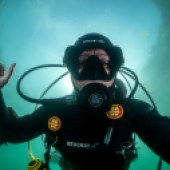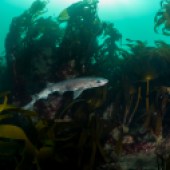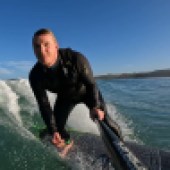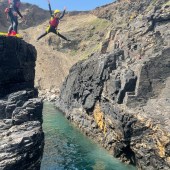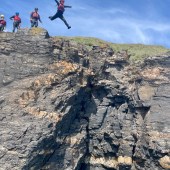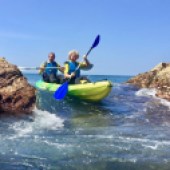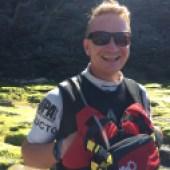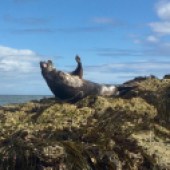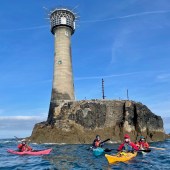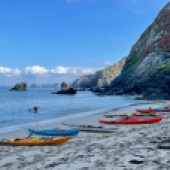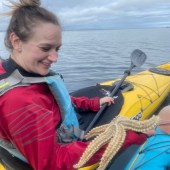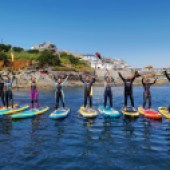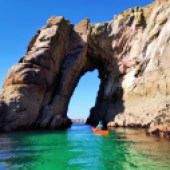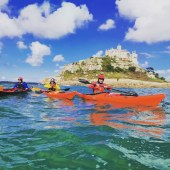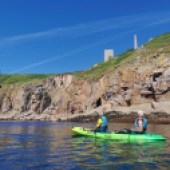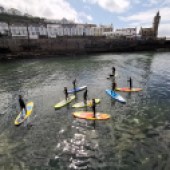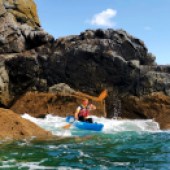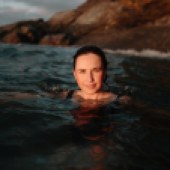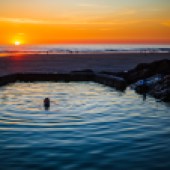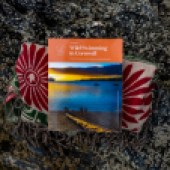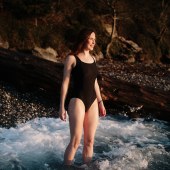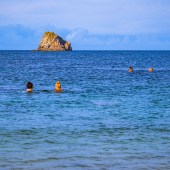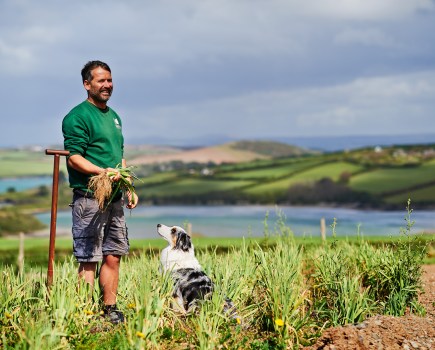Water life on the Cornish coast! Whether you’re surfing a 20ft wave, swimming with your friends, paddle boarding or diving, there are some fantastic places to explore. CHRISSY HARRIS finds out more.
Surfer Rob Fowlie is preparing for some serious swell. There’s talk of some 20 or 25 footers arriving off the north Cornwall coast in two days’ time and he wants to be there to enjoy it. Rob, 32, has built a name for himself, both locally and nationally, as a big wave surfer who likes to push the boundaries of what’s possible out there on the water (“cojones by the bucket load” was how one commentator put it).
Rob has certainly tasted the high life, but the Cornish-born self-employed electrician credits his home surf with providing the best training ground possible.
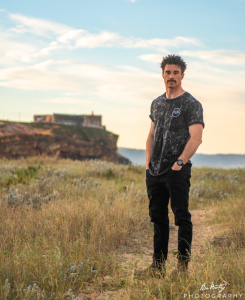
Surfer Rob Fowlie. Credit: Ben Hartley Photography
“When I was growing up, I would go to the beach and see people surfing and it blew my mind,” he says, describing how he caught the bug as a teenager. “I was fascinated with how you cope with it, how mentally you put yourself in the right place at the right time.”
Rob lives in St Agnes and perfects his training there or up the coast at Gwithian and Perranporth. For bigger swells, he heads to Newquay or else drops down the coast to Sennen.
“It depends on the time year but there are so many opportunities in Cornwall to outrun big waves,” says Rob, who recently secured sponsorship from aggregate company GRS to help continue his quest to join the world’s elite of big wave surfers. But size doesn’t always matter. Rob says he would recommend getting out on the water in Cornwall, whatever the wave situation. “Absolutely,” he says. “For me, it’s a way to escape or find peace. Being out there at that moment just takes over from everything else. Throughout this whole journey, I’ve been able blank out any fear. You train for the worst and prepare for the best.”
WHERE TO SURF
Gwithian and Perranporth are great places to start. Newquay is the surfers’ paradise with all the infrastructure in place. Lusty Glaze beach is a good starting point then the world-famous Fistral beach. Praa Sands, Helston, is a well-known spot but is big enough to take the numbers. Porthmeor Beach in St Ives can provide powerful waves on the right day but doesn’t pick up as much swell as most north coast beaches. Sennen is exposed and has a variety of surf conditions.
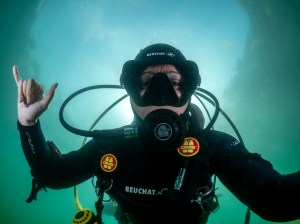
Diver Shannon Moran in her element underwater. Credit: Shannon Moran
Shannon Moran is an underwater photographer based in Falmouth. She began scuba diving in 2017 after graduating with a degree in marine and natural history photography from the University of Falmouth. Her photographs of a common octopus off the coast of the Lizard Peninsula were recently used by national media outlets to highlight an increase in the number of sightings of the marine creatures in Cornwall.
“In the UK, it’s Cornwall or Scotland which have the best reputations,” says Shannon, also a volunteer for the Falmouth RNLI water safety team and SeaSearch for the Cornwall Wildlife Trust. “In Scotland, the waters are cold and clear but in Cornwall, we get a lot more Mediterranean species. They tend to look a bit more flamboyant.”
Shannon’s top sightings include a rare sea slug, a basking shark, rays and, most recently, a tuna sighting.
“We were diving off the Lizard at Polkerris and they just swam past us,” says Shannon. “It was incredible. They were huge, probably about six foot in length, just these enormous, shiny fish. You don’t often get chance to see anything that big.”
Shannon says the waters off the Lizard are often good diving but she also loves exploring even closer to home.
“Around where I live in Falmouth is actually very good,” she says. “We’re really lucky here in Cornwall. On a good day, the visibility is anything between five and 15 metres,” she says, adding that she spends most her days underwater, either teaching in a swimming pool or out at sea.
“Once I’d started diving, I couldn’t stop – it’s quite addictive,” says Shannon. “I really enjoy it, especially because it helps to teach people about marine life and how we need to look after it.”
WHERE TO DIVE
As Shannon mentioned, the Lizard Peninsula is a must-dive. The perilous rocks off the coast here have wrecked countless ships. But it’s also a ‘scuba playground’ teeming with life. Closer to shore, Porthkerris Cove is considered one of the UK’s prettiest beach dives. Gullies and kelp provide shelter for all kinds of creatures, from anemones and urchins to cuttlefish and occasionally John Dory. Bude offers easy access to many sheltered dive sites, such as Dizzard Point. There are plenty of shallow and deep wreck sites.
Diving in the Isles of Scilly is a mixture of reef and wreck diving. There are dives to suit all abilities on steeped reefs. For advanced divers, there are walls of 50 metres and canyons. Tidal current is strong in the isles and they are close to the Gulf Stream, so there is a rich variety of marine life, including vibrantly coloured jewel anemones, corals and sponges.
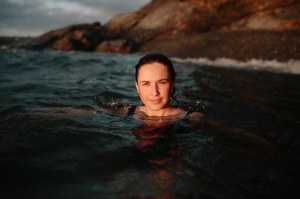
Wild Swimming Cornwall’s Lydia Paleschi. Credit: Rebecca Rees
Lydia Paleschi is co-founder of Wild Swimming Cornwall, established during lockdown to encourage more people to experience the benefits of being in cold water, surrounded by nature. She and co-founders Max Campbell and Bethany Allen have, quite literally, written the book on the best places to swim in and around the Cornish coast.
“Swimming in Cornwall is full of surprises and there are huge variations between locations,” says Lydia. “Whether you’re seeking out quiet tidal pools protected from the waves, sheltered rivers surrounded by ancient woodland, fresh-water quarries with extra-cold water or ocean swims at one of Cornwall’s hundreds of beaches, there’s always something new to discover.
“There are so many fantastic swim spots in Cornwall that you could go to a new location every day of the year and still not visit them all.”
Lydia’s favourite places to take a dip include the Helford River and Cornwall’s tidal pools, as well as her local waters.
“I live in Falmouth, so I tend to swim mostly from Gyllyngvase Beach which is often sheltered from any waves and gently shelves into the water, making it beginner-friendly,” says Lydia. “There are kelp forests and plenty of reef around Falmouth seafront, which also makes it great fun for snorkelling and open water swimming.”
Lydia tries to swim as often as she can, realising that spending time in the ocean is a powerful tool for emotional health and dealing with stress.
“Just two swims in a two-week period can improve our response to stress over the medium term and prolonged exposure has even greater benefits,” she says. “There’s a saying amongst the cold water swimming community that you ’never regret a swim’.”
The book A Guide to Wild Swimming in Cornwall is available via wildswimmingcornwall.co.uk
WHERE TO SWIM
Lansallos Cove in Looe has crystal clear waters. The Jubilee Pool in Penzance is an art deco seawater lido. Chapel Rock at Perranporth is home to a natural seawater pool. Nanjizal (pronounced Nanjizzle) is a natural rock arch and pool near Lands End. Porth Nanven is a stunning beach near St Just. It’s known as ‘dinosaur egg’ beach because of its distinctive smooth boulders.
For more Cornish activities to fill your staycation days, check out these 10 best days out in Cornwall.

